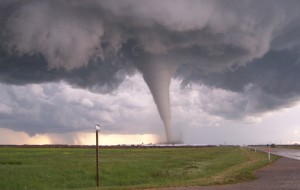 At the airport bar, where I have met some of the most amazing people, I recently met a young storm chaser named Brenton Gill. I am always in awe of people who are pushing their lives to the limit, doing incredible things and inspiring others. He’s one of them. Here’s his story:
At the airport bar, where I have met some of the most amazing people, I recently met a young storm chaser named Brenton Gill. I am always in awe of people who are pushing their lives to the limit, doing incredible things and inspiring others. He’s one of them. Here’s his story:
How did you get interested in storm chasing? My interest in thunderstorms started when I was about 5 years old. I was sitting in class, the tornado sirens went off and the teacher gathered all of the students in the bathroom to take shelter. I opened the double doors of the school, took a step outside into the humid, dark gray air, I looked up at the sky and about a mile away was a funnel cloud dropping out of the base of an enormous, near black wall cloud. I was mesmerized. I’ll never forget that sight, it was beautiful, scary and awe inspiring all at the same moment.
Ever since then, I’ve never been able to take my eye off of the sky when a storm is brewing. I guess that’s why I storm chase now, because I love the adrenaline rush of seeing one of nature’s most rare and powerful events.
Tell me about the storm experience where you were following the same storm as the STORMCHASERS crew. My roommates and I were driving into NW Oklahoma to set up for an afternoon of storm chasing. After pulling off on a dirt road adjacent to the highway, we were quickly engulfed by the core of the storm; raindrops the size of grapes were pounding the car, golf ball size hail was pinging of the roof and lightning was striking the ground. We realized we were in very bad position to intercept a tornado, so we pulled back up to the highway. As soon as we did, the TIV (tank-looking Tornado Intercept Vehicle from the Stormchaser show) zooms past. I yell, “Follow it!!!” We pulled out onto the highway heading east, the TIV in the lead, followed by its Discovery Channel production truck, us and about 10 other storm chasing crews.
 About a mile away I saw a shaft of rain about the width of a football stadium. We have no radar connection in our car, so we can’t check the radar for a tornado signature. I knew the TIV and its production truck did have radar, and that the production truck would not drive into a tornado, so I figured we’d be safe as long as we followed them.
About a mile away I saw a shaft of rain about the width of a football stadium. We have no radar connection in our car, so we can’t check the radar for a tornado signature. I knew the TIV and its production truck did have radar, and that the production truck would not drive into a tornado, so I figured we’d be safe as long as we followed them.
I looked up and this huge column of whirling rain is now less than 200 yards from us. “Oh my God, it’s rotating!”. I can see the rain wrapping horizontally and realized there was a good chance there was a small tornado wrapped up in the rain. BHAM! Visibility goes from clear to almost nothing. We could feel the car being blown towards the opposite side of the road, while simultaneously feeling a bit lighter. I look to my right and see a herd of cows pushed up against a barbed-wire fence, their weight being pushed by the wind and causing the fence to bulge outward. We continued to follow the production truck until we finally got ahead of the tornado and the whole caravan of cars pulled over and starting high-fiving and hugging each other.
What is the most amazing storm you have ever seen. One of the most amazing storms I have ever seen occurred in Oklahoma near the towns of Kingfisher and Guthrie. The forecast by the storm Prediction Center called for a High Risk of severe storms. It was a beautiful thunderstorm that sprouted up in northwest Oklahoma and quickly grew into a large supercell thunderstorm. We were out on a dirt road and witnessed a beautiful, extremely low to the ground rotating wall cloud heading right for us. The storm produced a wedge shaped tornado, became wrapped up in rain, making it nearly invisible to the naked eye. The tornado produced near Dover had dissipated by this point, but was still capable of producing more. It came near us again, a beautiful gray wall cloud head towards us over the vibrant green pastures. When the wall cloud was directly overhead, we could see the cloud bands at the base of the storm being “sucked” into the wall cloud and spun around the center of the circulation. A funnel began to form and slowly dropped down, all the while the rotation became more pronounced and the speed at which everything was happening seemed to intensify. The rotation I was seeing at this point was akin to the rotation one might see when they drain a full sink and a vortex forms over the drain.
See photos taken by Jennifer Myers here
How close have you been to a tornado? I’ve been in/hit by a tornado, that was admittedly a little too close for comfort, staying a few hundred yards away is usually a better idea.
What would be the ultimate chase? My ultimate fantasy chase would be to chase a storm that produces a large and powerful, long-lived tornado through some open countryside. I would love to be able to follow an EF-5 tornado, which has wind speeds in excess of 200 mph, across multiple countries, and an intense lightning show along with this dream tornado would be a nice bonus.
Describe the process of chasing a storm (planning, equipment, etc). The first thing to watch for is favorable synoptic weather conditions that allow for the development of thunderstorms and hopefully supercells. The most favorable synoptic conditions occur when cold dry air from the north collides with warm moist air from the Gulf. Next, we’ll look for areas within this large-scale set-up that are more favorable for supercell formation, for simplicity we’ll use the acronym M.I.S.T. which stands for Moisture, Instability, Shear and Trigger; you want warm moist air at the surface, cold dry air aloft in the atmosphere, a favorable vertical wind-profile throughout the atmosphere and some sort of trigger to cause the initial lifting and formation of thunderstorms.
On the day of the chase, we drive out into this location early and wait for storms to develop. Once they develop, we use radar to track the storms, view their intensity and analyze wind profiles in the storms to look for tornado signatures. We also rely fairly heavily on our eyesight to see what the storms are doing.


